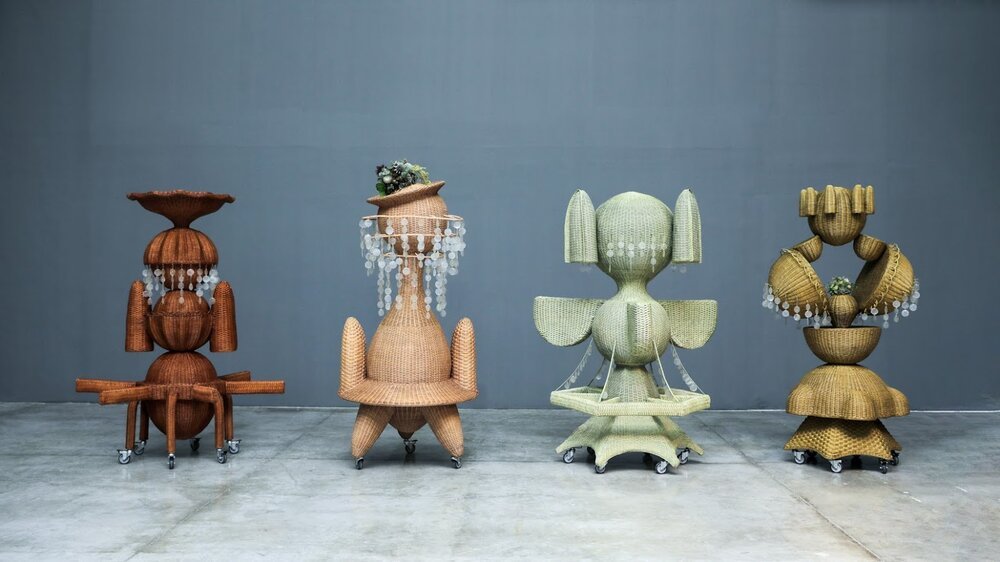‘The Tailors and The Mannequins: Chen Cheng Mei and You Khin’
Debut presentation at ‘Dalam Southeast Asia’
By Ian Tee
This article is presented in partnership with National Gallery Singapore.
‘The Tailors and The Mannequins’, 2021-22, exhibition view at Dalam Southeast Asia. Image courtesy of National Gallery Singapore.
‘Dalam Southeast Asia’ is a new project space at the National Gallery Singapore (NGS). Housed within its long-term display ‘Between Declarations and Dreams’, the project space is dedicated to understudied artists and lesser-known narratives. Its name ‘Dalam Southeast Asia’ draws from the Malay word dalam meaning “inside”, and points to aspects from “within” the Gallery’s collection that is yet to be uncovered.
The inaugural exhibition ‘The Tailors and the Mannequins: Chen Cheng Mei and You Khin’ highlights the works of two outliers in regional art history. Though Chen and You lived vastly different lives and did not know each other, they shared an affinity for portraying everyday scenes in diverse locations. The exhibition tracks their movements across the world from the 1970s until the 2000s, with a particular focus on their representations of peoples and places in far-flung places. In doing so, the show aims to address this central question: How is the world, including Africa, the Middle East, South Asia and beyond, imagined and encountered in Southeast Asia’s modern art?
“How is the world, including Africa, the Middle East, South Asia and beyond, imagined and encountered in Southeast Asia’s modern art?”
‘The Tailors and The Mannequins’, 2021-22, exhibition view at Dalam Southeast Asia. Image courtesy of National Gallery Singapore.
‘The Tailors and The Mannequins’, 2021-22, exhibition view at Dalam Southeast Asia. Image courtesy of National Gallery Singapore.
Curator Roger Nelson adopts a comparative approach by pairing You and Chen. It is a decision that brings their similarities and differences into sharp relief. You was born and studied in Cambodia, but lived as a refugee in France, Sudan, Qatar and the United Kingdom after the Khmer Rouge took power in 1975. In contrast, Chen was the daughter of an affluent business person and resided in Singapore her entire life. She was also the initiator of the Ten Men Art Group, an informal group best known for their field trips around Southeast Asia in the 1960s. Independently, Chen went on dozens of such study trips to further regions, an evidence of her adventurous and outgoing nature.
You Khin, ‘Untitled (Meeting Above Pigeon Cages)’, 1978, oil on canvas, 65 x 100cm. Collection of National Gallery Singapore.
Chen Cheng Mei, ‘Market’, 1980, oil on canvas, 83.5 x 76.5cm. Gift of anonymous donor. Collection of National Gallery Singapore.
Yet, both artists shared what Nelson calls a “planetary consciousness, respecting the diverse peoples they encountered and represented in their art, and recognising that cultures can never be completely understood from the outside.” Their paintings often depict ordinary people in quotidian moments, absorbed in their daily tasks. You’s ‘Untitled (Meeting Above Pigeon Cages)’ (1978) captures the frantic energy at a market in Khartoum, with quick brushstrokes and impasto. Approaching the same subject with chromatic flair, Chen used vivid hues of red, orange and violet to set a mood in ‘Market’ (1980).
The two artists also ventured far with their experiments in composition. In the aforementioned painting by You, one’s gaze is guided across the picture plane in a circular motion, with no space to rest. It has a complex underlying structure of overlapping grids and circle forms which bring the figures in and out of focus. In contrast, Chen’s ‘Market’ features an unusual perspective which highlights the make-shift structures in the space. This sense of architecture is juxtaposed by the colour field background. The respective artists’ sensibilities come through strongly in the distinct aesthetic experiences their works offer.
“Yet, both artists shared what Nelson calls a “planetary consciousness, respecting the diverse peoples they encountered and represented in their art, and recognising that cultures can never be completely understood from the outside.”
‘The Tailors and The Mannequins’, 2021-22, exhibition view at Dalam Southeast Asia. Image courtesy of National Gallery Singapore.
You Khin and Chen Cheng Mei complicate how one imagines “Southeast Asian modern art” as a category, bringing to the fore divergent experiences of different nations in the region. At the same time, their artworks and personal archives also make apparent connections between Southeast Asia and other parts of the Global South. In his curatorial essay, Nelson makes the argument to also consider their works through ideas they would have encountered during their travels, such as those propagated by the New Vision Artist Group from Iraq and in Pan-African Cultural Manifesto. No doubt, these affinities warrant further research and ‘The Tailors and The Mannequins’ is a compelling testbed for more of such efforts.
Watch an exhibition tour by Roger Nelson:
‘The Tailors and The Mannequins: Chen Cheng Mei and You Khin’ is on view at Dalam Southeast Asia, National Gallery Singapore from 29 October 2021 to 12 June 2022. Click here for more information and to access the exhibition catalogue.




















